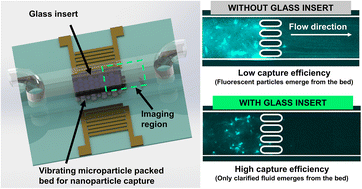Glass-embedded PDMS microfluidic device for enhanced concentration of nanoparticles using an ultrasonic nanosieve†
Abstract
Surface acoustic wave (SAW) driven devices typically employ polymeric microfluidic channels of low acoustic impedance mismatch to the fluid in contact, to allow precise control of the wave field. Several of these applications, however, can benefit from the implementation of an acoustically reflective surface at the microfluidic channel's ceiling to increase energy retention within the fluid and hence, performance of the device. In this work, we embed a glass insert at the ceiling of the PDMS microfluidic channel used in a SAW activated nanosieve, which utilises a microparticle resonance for enrichment of nanoparticles. Due to the system's independence of performance on channel geometry and wave field pattern, the glass-inserted device allowed for a 30-fold increase in flow rate, from 0.05 μl min−1 to 1.5 μL min−1, whilst maintaining high capture efficiencies of >90%, when compared to its previously reported design. This effectively enables the system to process larger volume samples, which typically is a main limitation of these type of devices. This work demonstrates a simple way to increase the performance and throughput of SAW-based devices, especially within systems that can benefit from the energy retention.



 Please wait while we load your content...
Please wait while we load your content...